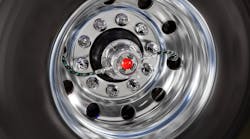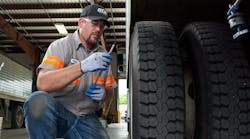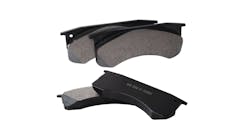Tires can be one of the most costly maintenance items for a heavy duty commercial truck fleet. With the amount of time trucks spend on the road, tires need to be replaced relatively frequently - and that’s no small expense.
To help reduce this cost, many fleets turn to retreads. Retreading basically reconditions a tire for a second or third use, and sometimes more. This can significantly increase the return on investment for each new tire a fleet purchases.
According to the Tire Retread and Repair Information Bureau (TRIB), a non-profit industry association that provides information on tire retreading (retread.org), 90 percent of fleets with 1,000 or more trucks use retread tires. This includes fleets such as Ryder, Penske, UPS, FedEx, and the U.S. Army.
There are several considerations, however, when it comes to using retreads safely and efficiently. It is important fleets use retreads properly to get the most from this investment.
Benefits of retreading
There are two main benefits to using retreads instead of strictly specifying brand new tires. One, as noted above, is economical. The other is environmental.
Economical considerations
Retreads are a more cost-effective solution for fleets than using new tires because the out-the-door cost of a retread is much less than a new tire. Since the fleet is only purchasing new tread, the physical material and associated labor costs are both less than they would be for a new tire.
“The utilization of new tires versus retreads depends on the unique needs of individual fleets and owner-operators,” says Nick Davis, senior product marketing manager for Goodyear. “The decision often boils down to cost. The acquisition price for a retread can be as much as 60 percent less than a new tire, while providing like-new tread wear and traction performance.”
This lower price tag helps recoup the cost of the initial tire purchase when it was new. According to Ron Elliot, marketing, communications, and inside sales manager for Marangoni Tread North America, about 70 percent of the cost of a new tire is in the tire casing. The casing is the layer of tire beneath the tread - basically, the foundation that the tread sits on. Being able to use a casing more than once increases the mileage a fleet can get from that tire, decreasing the tire’s cost per mile.
Environmental considerations
In addition to cost savings, retreads are also beneficial from an environmental standpoint. Reusing tires instead of discarding them helps limits used tires from ending up in landfills. Retreading helps to defer millions of tires from landfills each year, according to TRIB.
Retreads also help reduce oil usage, since it takes approximately seven gallons of oil to produce a retread versus 22 gallons to produce a new tire. This helps save North America more than 400 million gallons of oil each year, according to the U.S. Environmental Protection Agency (EPA).
The retread process
Manufacturers typically follow a basic set of steps outlined by TRIB to produce a safe and reliable retread tire.
Each step must be completed properly for the retread tire to have sufficient integrity, say Phil Boarts and Glenn Stockstill, product category managers, retread, Michelin. Michelin Retread Technologies (MRT) and Oliver Rubber retreaders use proprietary processes to repair and retread tire casings to ensure this safety.
Michelin and other retread companies customize their retread process to meet their own standards, but the basics of the process remain virtually the same.
- Initial inspection. Retreading is only possible if the casing is in good condition, so this step is critical. Experts inspect the casing for obvious signs of significant damage that would indicate the tire is unsafe to retread, or that it would not survive another duty cycle.
- Non-destructive testing. If the casing passes initial inspection, it goes on to another round of more in-depth testing to find any potential internal damage not visible to the human eye. This usually involves shearography, ultrasound, or X-ray. “Shearography generates detailed images of the total casing to identify any underlying damage and can even measure casing abnormalities or separations smaller than the diameter of a human hair,” says LaTres Jarrett, director of marketing for Bandag, U.S. and Canada, Bridgestone Americas Tire Operations.
- Buffing. “Once through these initial inspections, a casing is buffed to remove the original tread,” Jarrett continues. In this step, the casing is mounted on a lathe-type machine and inflated. Then, a computer-controlled rasp shaves off the old, used tread while the casing spins. This process is completed to exact specifications to ensure the casing is the right shape to support the new tread.
- Casing preparation and repair. Next, an expert determines whether any imperfections that remain after buffing can be repaired or not. If it is determined that damage is too extensive or outside acceptable parameters, the casing will be rejected. Otherwise, the expert will repair any imperfections to make sure the casing will last the life of the new tread.
- Tread application. Once the casing has been inspected, buffed, and repaired, it is ready to receive its new tread. There are two methods for attaching new tread to the casing: mold cure and precure.
- Mold cure. In this process, uncured tread rubber is added to the casing until it is the correct diameter for the new tread specifications. Then, inflated to the correct pressure, the casing is placed into a mold, which shapes the uncured rubber into a tread pattern.
- Precure. This method uses a pre-formed and cured tread, either in a strip or full circle, and attaches it to the casing using a layer of uncured rubber. A strip tread will have to be spliced together once applied, whereas a full circle can be applied with no seams or splices.
- Curing. Also known as vulcanizing, curing is the process of securing the new tread to the casing. The soft, uncured rubber is hardened into the tough, long-lasting tread. If the tread was added using the mold cure method, the tire will be heated in its mold for a specific amount of time to cure the new tread rubber. If the tread was added using the precure method, the tire is placed into a rubber membrane which is then sealed and has the air sucked out. This is then placed into a chamber where heat and pressure are applied for a set amount of time to cure the layer holding the tread to the casing.
- Final inspection. After curing, the retread tire undergoes a final inspection to ensure there are no flaws and the tire will prove reliable for the customer.
Tire management
Retreads can be beneficial to fleets, but it is important to have a tire management program in place to fully realize these benefits. A fleet with a sound tire management program in place will often have a set rotation for the tires on its vehicles.
“Most fleets with good tire management programs purchase new steer tires, and then retread those casings for use on the drive and trailer axles,” says Marangoni’s Elliot.
Many fleets will use new tires on the front axle, and second- and third-life retreads on the second two (drive) axles and trailer before pulling the tires from service.
Michelin’s Boarts and Stockstill agree that the pull point should maximize the number of retreads per casing and include an age of service limitation for the first, second, and third life of the retreads and their position. Some urban or severe service fleets, such as sanitation fleets, can retread six to seven times on a quality casing, they say, adding that any tire coming out of service should be evaluated for damage and documented. This evaluation will help the fleet determine the best future tire selections for the application and for the best overall value.
Regular maintenance is the same for retreads as it is for new tires. Bandag’s Jarrett recommends the following best practices for proper tire care:
- Select the right tire for the application, considering proper size, load carrying capacity, speed capability, and service type.
- Maintain proper cold inflation pressure for every tire before each haul.
- Inspect tires for road-related damage such as cuts, cracks, bulges, and penetrations.
- Do not exceed the maximum recommended speed of a tire.
It is also imperative to monitor tread depth to determine when to replace or retread tires. Government regulations require replacement at or before 4/32” on steer tires and 2/32” for all other tire positions. However, TRIB warns that it can be risky to wait until a tire has reached this limit to retread, since at that point there is very little tread left to protect the casing from permanent damage that could render the tire unusable.
If there is any doubt about tire maintenance or when and where using retreads is appropriate, a fleet can also utilize its tire and retread provider as a resource for recommended practices when it comes to new and retread tires. Tire specialists can provide a wealth of knowledge to help optimize a fleet’s tire program to get the most life, and therefore value, out of each tire.
Considerations for retreading
There are many important factors a fleet should take into account when considering retreads for its vehicles. From new tire purchases to retread type, it’s worth reviewing the fleet’s goals before settling on a plan of action.
The most important quality when it comes to retreading is using a casing that is in good condition. While higher quality casings may be more expensive to purchase new, they can often be retreaded more times than less expensive casings, leading to a lower overall cost per mile.
“In every situation, a tire’s retreadability starts with the quality of its casings,” says Goodyear’s Davis. “Fleets that want to optimize their new tire investment through retreading should always start with premium casings that have been maintained properly.”
Another factor to consider is the type of tread to attach to the new casing. Like new tires, retreads can be specified for a variety of vehicle positions and applications.
“The two most common positions are trailer and drive,” says Tom Clauer, senior manager of commercial and OTR product planning for Yokohama Tire. “This is mainly due to the cost savings. Trailer tire retreads are lighter weight and don’t have the stresses put on them as do drives. Drive retreads are much heavier and require a top-tier casing… to handle the heat and yet retain the cap.”
Clauer adds that drive position retreads also have much more demands placed on them, primarily traction for acceleration and braking. In more severe operations, there can be additional stresses due to loose materials where wheel spin and coarse material damage is a potential issue.
He also notes that fleets need to select the right tread for vehicle usage. Highway operations usually require more shallow tread depths, lower rolling resistance, and resistance to heat at high speeds. Fleets often use top-tier tires that they purchased new for the same properties.
Modern technologies
Present-day technologies have made the retread process more accurate and economical than ever. During the inspection process, high tech non-destructive testing processes ensure casings are suitable to be reused.
“Because of technologies like shearography, fleets can feel confident a casing is suitable for retreading and that tires aren’t pulled from service too early, leaving money on the table,” says Bandag’s Jarrett.
Computer-guided systems buff and retread tires to exact specifications, leaving no doubt in the quality of the retread, and full-circle tread technology – such as Goodyear’s UniCircle and Marangoni’s Ringtread – allow for seamless application.
“The seamless UniCircle tread is applied to casings using laser-guided technology, after which the tread is precision-stitched,” says Goodyear’s Davis. “Because there is no cutting during the UniCircle tread application process, the resulting retread is uniform and balanced, which helps extend casing life and mileage.”
The entire process is also more efficient than ever before. Marangoni’s Elliott notes that the introduction of advanced computer-controlled tire equipment in today’s retreading plants has resulted in higher speed production.
Conclusion
There are clear benefits to using retreads for a fleet’s tire replacement needs. They make economical sense for many fleets, and they help to reduce use of oil and the amount of tires making their way to landfills. Additionally, drawbacks that may have once been present are virtually nonexistent thanks to modern technologies that have distilled the retread process down to an exact science.
Still, retreads may not be the perfect solution for every vehicle in every fleet. It is imperative for a fleet to do proper research and utilize all resources, including tire and retread manufacturers. Perhaps most importantly, fleets should implement and adhere to a comprehensive tire management program to ensure their vehicle’s tires are being utilized safely and efficiently.





